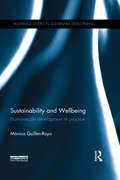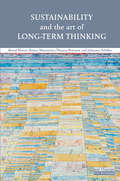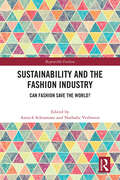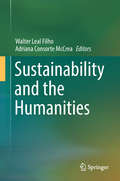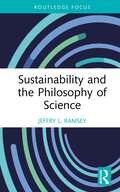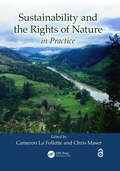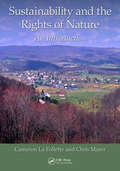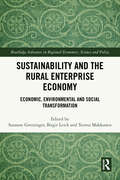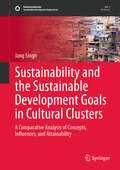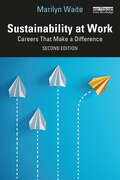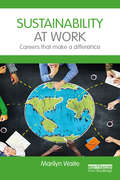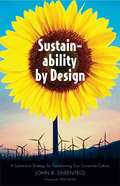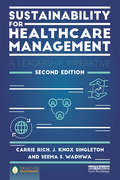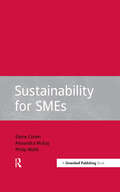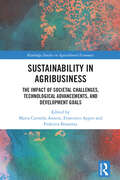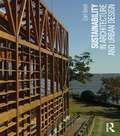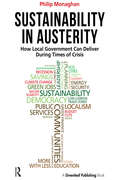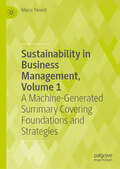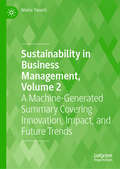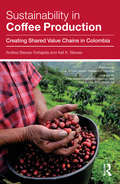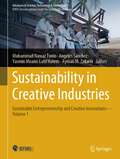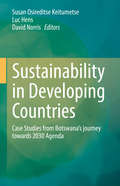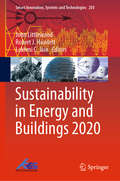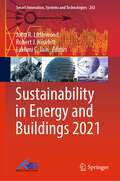- Table View
- List View
Sustainability and Wellbeing: Human-Scale Development in Practice (Routledge Studies in Sustainable Development)
by Mònica Guillen-RoyoThe idea that we can meet human needs and simultaneously conserve and even enhance the natural environment is an attractive one. Since the Brundtland report popularised a definition of sustainable development based on the concept of needs, there has been a widespread belief that it should be possible to achieve a good quality of life without compromising natural ecosystems. Sustainability and Wellbeing fills a gap in sustainable development studies by drawing on a range of case-studies to discuss the challenges and opportunities of using Max-Neef’s Human Scale Development (HSD) framework in practice. The first section presents the theory and the methodology of HSD in the context of related literature on sustainable development and wellbeing. The second section discusses applications of the HSD methodology with three different purposes: the design of sustainable development interventions; the engagement of researchers with communities or groups of people in sustainability processes and the consolidation of sustainable community initiatives. Finally, the third reflects on challenges and limitations of using the HSD approach to define strategies for sustainable development and concludes. This is an invaluable resource for researchers and postgraduate students in wellbeing, sustainability, sustainable development, and human development.
Sustainability and the Art of Long-Term Thinking (Routledge Studies in Sustainability)
by Thomas Petersen Bernd Klauer Reiner Manstetten Johannes SchillerDealing with time is intimately linked to sustainability, because sustainability, at its core, involves long-term ethical claims. To live up to them, decision and policy-making has to consider long-term development of society, economy, and nature. However, dealing with time and such long-term development is a notoriously difficult subject, both in science and, in particular, in practical decision and policy making. Rooted in philosophical and scientific reasoning, this book explores how the concept of time can be incorporated into effective practical action. The book describes a system and uses case studies to help sustainability practitioners and researchers consider the long-term consequences of our actions in a methodical way. The system integrates scientific and practical knowledge about time and temporal developments to help break down the sometimes overwhelming complexity of sustainability issues. Combining theoretical conceptual thinking and practical applications, this book will be of great interest to students and researchers of sustainability science, environmental sciences, sustainable development, environmental economics, political sciences and practical philosophy.
Sustainability and the Fashion Industry: Can Fashion Save the World? (Responsible Fashion)
by Annick Schramme Nathalie VerbovenThere is widespread rhetorical agreement that the fashion industry must get itself onto a more ethical and sustainable footing. What does this mean in practice, and how can this be achieved in different regions around the world?This book brings together expert scholars and reflective practitioners via a network of dialogue and exchange to help drive forward an ethical and sustainable future for the fashion industry. With insights from fashion design, management, sociology, philosophy, education, heritage studies and policy, the book asks whether or not fashion can save the world.Enriched with illuminating case interviews and the perspective of experts, this book will be of interest to researchers and scholars in the fields of sustainable business and the fashion industry, and provides a unique resource for readers seeking to understand more about the need for responsible fashion.
Sustainability and the Humanities
by Walter Leal Filho Adriana Consorte McCreaThis book explores the strong links between sustainability and the humanities, which go beyond the inclusion of social sciences in discussions on sustainability, and offers a holistic discussion on the intellectual and moral aspects of sustainable development. The contributions from researchers in the fields of education, social sciences, religion, humanities, and sustainable development fulfill three main aims:They provide university lecturers interested in humanities and sustainable development with an opportunity to present their work;foster the exchange of information, ideas and experiences acquired in the execution of teaching and research; anddiscuss methodological approaches and projects that provide a better understanding of how the humanities can contribute to the debate on sustainable development. Prepared by the Inter-University Sustainable Development Research Programme and the World Sustainable Development Research and Transfer Centre, the book reiterates the need to promote integrated approaches to sustainable development. Including practice-based lessons learnt that can be replicated further, it is a valuable resource for scientists and practitioners working in the humanities and sustainable development.
Sustainability and the Philosophy of Science (Routledge Focus on Environment and Sustainability)
by Jeffry L. RamseyThis book demonstrates how the philosophy of science can enhance our understanding of sustainability and the practices we use to enact it. Examining assumptions about concepts, theories, evidence, and the moral ideals of sustainability can better orient us as we pursue this urgent and important goal. The book applies perspectives and tools from the philosophy of science – construed broadly to include portions of science and technology studies, history of science, and philosophy more generally – to sustainability discourse. It argues that widely held assumptions regarding the meaning of concepts, methods of theorizing and inferential practice, evidential structure, and ethics limit our understanding and practice of sustainability. It offers philosophical alternatives that capture more fully the confusing, wicked nature of sustainability challenges. The alternatives draw attention to existing but often undervalued frameworks in sustainability discourse. This book is aimed towards academics, researchers, and post-graduates working in sustainability, as well as philosophers of science and environmental philosophers interested in the philosophical issues raised by the pursuit of sustainability.
Sustainability and the Rights of Nature in Practise (Social Environmental Sustainability)
by Chris Maser Cameron La FolletteSustainability and the Rights of Nature in Practice is the much-needed complementary volume to Sustainability and the Rights of Nature: An Introduction (CRC Press, May 2017). The first book laid out the international precursors for the Rights of Nature doctrine and described the changes required to create a Rights of Nature framework that supports Nature in a sustainable relationship rather than as an exploited resource. This follow-up work provides practitioners from diverse cultures around the world an opportunity to describe their own projects, successes, and challenges in moving toward a legal personhood for Nature. It includes contributions from Nepal, New Zealand, Canadian Native American cultures, Kiribati, the United States and Scotland, amongst others, by practitioners working on projects that can be integrated into a Rights of Nature framework. The authors also tackle required changes to shift the paradigm, such as thinking of Nature in a sacred manner, reorienting Nature’s rights and human rights, the conceptualization of restoration, and the removal of large-scale energy infrastructure. Curated by experts in the field, this expansive collection of papers will prove invaluable to a wide array of policymakers and administrators, environmental advocates and conservation groups, tribal land managers, and communities seeking to create or maintain a sustainable relationship with Nature. Features: Addresses existing projects that are successfully implementing a Rights of Nature legal framework, including the difference it makes in practice Presents the voices of practitioners not often recognized who are working in innovative ways towards sustainability and the need to grant a voice to Nature in human decision-making Explores new ideas from the insights of a diverse range of cultures on how to grant legal personhood to Nature, restrain damaging human activity, create true sustainability, and glimpse how a Rights of Nature paradigm can work in different societies Details the potential pitfalls to Rights of Nature governance and land use decisions from people doing the work, as well as their solutions Discusses the basic human needs for shelter, food, and community in entirely new ways: in relationship with Nature, rather than in conquest of it
Sustainability and the Rights of Nature: An Introduction (Social Environmental Sustainability)
by Chris Maser Cameron La FolletteSustainability and the Rights of Nature: An Introduction is a much-needed guide that addresses the exciting and significant paradigm shift to the Rights of Nature, as it is occurring both in the United States and internationally in the fields of environmental law and environmental sustainability. This shift advocates building a relationship of integrity and reciprocity with the planet by placing Nature in the forefront of our rights-based legal systems. The authors discuss means of achieving this by laying out Nature’s Laws of Reciprocity and providing a roadmap of the strategies and directions needed to create a Rights of Nature-oriented legal system that will shape and maintain human activities in an environmentally sustainable manner. This work is enriched with an array of unique and relevant points of reference such as the feudal notions of obligation, principles of traditional indigenous cultivation, the Pope Francis Encyclical on the environment, and the new Rights of Nature-based legal systems of Ecuador and Bolivia that can serve as prototypes for the United States and other countries around the world to help ensure a future of environmental sustainability for all living systems.
Sustainability and the Rural Enterprise Economy: Economic, Environmental and Social Transformation (Routledge Advances in Regional Economics, Science and Policy)
by Birgit Leick Susanne Gretzinger Teemu MakkonenEnterprises in rural regions must now act in a globalized world and face global challenges, such as climate change, resource scarcities and social inequalities or the sustainability preferences of consumers. Rural start-up enterprises often strive to contribute to the solutions of global-scale problems, for example, the issues expressed by the United Nation´s Sustainable Development Goals, and for getting skilled labor into urban regions in order to make rural regions appealing to young people again. This book explores the management of sustainability issues in the context of the rural enterprise economy.It sheds light on these challenges and opportunities by linking the rural enterprise economy and sustainability management. It provides practical evidence about how rural enterprises and rural entrepreneurs can handle sustainability requirements and contribute to sustainability transformations in terms of economic, environmental and social stability. In addition to its practical relevance, the motivation of the book is first and foremost to develop a common understanding of the necessary key terminology and core concepts in a still largely underexplored, yet rapidly expanding research field and contribute to theory development by employing a multidisciplinary approach. It offers state-of-the-art cases from various countries to question and approach unresolved research questions related to sustainability issues and the management of sustainability, which are both a requirement and an opportunity for entrepreneurs and enterprises in a rural context.The book primarily targets scholars and researchers in economics and business research, entrepreneurship, innovation, regional planning, economic geography and sustainability management. It is also aimed at practitioners committed to enterprise development or entrepreneurship in rural regions and elsewhere, and policymakers and policy actors at different levels.
Sustainability and the Sustainable Development Goals in Cultural Clusters: A Comparative Analysis of Concepts, Influences, and Attainability (Sustainable Development Goals Series)
by Jang SinghThis book examines the three pillars of sustainability (physical environment, social issues, and economic justice) and the progress and achievability of the United Nations’ (UN) 17 Sustainable Development Goals (SDGs) in Canada, Guyana, India, Sri Lanka, and the USA. It presents data from interviews with 41 political and business leaders in these five countries to examine the political and professional effects on sustainability. In addition to the three pillars of sustainability, the author briefly examines the role of religion in sustainability as a potential fourth pillar. The UN SDGs represent minimum targets for the global environmental, economic, and social pillars that underpin a sustainable future for our planet. The data presented in this book combined with the themes uncovered with the SDGs adds to our understanding of how we can potentially influence and achieve these targets and create a sustainable future for the world.
Sustainability at Work: Careers That Make a Difference
by Marilyn WaiteSustainability at Work is a compelling guide for anyone who seeks both a successful career and a career that makes a positive difference in society.Containing career advice of great value to students and professionals, and explaining how one can integrate sustainability into future roles, this book’s appeal extends far beyond those well versed in sustainability thinking. The text includes an easy-to-follow structure—the SURF Framework—that anyone wondering how they can make a difference in the workplace can apply. In this thoroughly revised new edition, Marilyn Waite builds upon recent career trends to include two all-important themes that are redefining sustainability: justice, equity, diversity, and inclusion and climate-related career pathways. In addition, practical advice for finding and creating roles that correspond to one’s preferences and purpose is elaborated. The book explains how real people in a plethora of sectors can have a positive impact on people and planet. Professionals from a variety of backgrounds and locations explain how they brought a sustainability approach to various sectors, including agriculture, business, economics, and financial services, education and research, entertainment and media, health care, law and policy, and science and technology. The breadth of stories covers individuals working on five continents in various levels of responsibility.Through inspiring narratives and a structured framework, Sustainability at Work illustrates how sustainability can be incorporated into every imaginable career to impact the quadruple bottom line: environment, economy, society, and future generations.
Sustainability at Work: Careers that make a difference
by Marilyn WaiteSustainability at Work is a compelling guide for everyone who wants to have both a successful career and a career that makes a positive difference in society. Containing career advice of great value to students of sustainability, and explaining how they can apply their knowledge to their future careers, its appeal extends well beyond the classroom. Sustainability at Work includes an easy-to-follow framework that anyone wondering how they can make a sustainable difference in the workplace can apply. Professionals from a variety of backgrounds and territories explain how they brought a sustainability approach to various sectors: agriculture, health care, business, economics, and financial services, education and research, law and policy, science and technology, and entertainment and media. Through inspiring narratives and a structured framework, Sustainability at Work illustrates how sustainability can be incorporated into every imaginable career to impact the quadruple bottom line: environment, economy, society, and future generations.
Sustainability by Design: A Subversive Strategy for Transforming Our Consumer Culture
by John R. EhrenfeldJohn Ehrenfeld challenges conventional understandings of solving environmental problems and offers a radical set of strategies to attain sustainability.
Sustainability for Healthcare Management: A Leadership Imperative
by Carrie R. Rich J. Knox Singleton Seema S. WadhwaSustainability is not unique to health, yet sustainability is a unique vehicle for promoting healthy values. This book challenges healthcare leaders to think through the implications of our decisions from fiscal, societal and environmental perspectives. It links health values with sustainability drivers in order to enlighten leadership about the value of sustainability as we move toward a new paradigm of health. Fully updated for the second edition, the book now includes case studies about: Waste disposal and cost Chemicals of concern Cost of water Green building ratings This book is a unique resource for researchers, students and professionals working in health and healthcare management because the book connects key concepts of environmental sustainability with healthcare operations. Readers will gain an appreciation for translating leadership priorities into sustainability tactics with beneficial operational outcomes.
Sustainability for SMEs: Competitive Advantage Through Transparency (Doshorts Ser.)
by Philip Wolfe Elaine Cohen Alexandra McKaySustainability for SMEs offers a comprehensive introduction to the key business cases and techniques for putting sustainability at the heart of your business strategy.Small businesses make a significant collective impact on the environment and society – but only a tiny percentage of SMEs complete a sustainability report. Sustainability Reporting for SMEs will enable any SME to get up to speed on sustainability reporting and plot a course of action for their business. Elaine Cohen distils the latest and best thinking on sustainability reporting for SMEs, and offers a process for reporting that will deliver significant business advantage, both in terms of more effective internal processes and in terms of reputation, customer loyalty and business-building.In many SMEs sustainability is one person’s passion and responsibility. A large part of their job becomes selling sustainability to other people in the business. Strategic Sustainability offers arguments, information and tactics that will help that person get the buy-in they need to move sustainability forward in their business. Sustainability is of strategic importance to a business. This book makes an airtight case for why action is essential and how sustainability can help a business not only survive but thrive in competitive marketplaces.The major environmental impact of most businesses derives from energy usage. There are many ways to make your organisation's energy usage more sustainable. In Sustainable Energy Options for Business, Philip Wolfe outlines the best available options for (1) reducing energy use and (2) improving the sustainability of energy supply. After an introduction to regulatory drivers and management issues, Wolfe looks at energy opportunities in five key areas.
Sustainability for a Warming Planet
by Humberto Llavador Joaquim Silvestre John E. RoemerHuman-generated greenhouse gas emissions imperil a global resource: a biosphere capable of supporting life as we know it. What is the fair way to share this scarce resource across present and future generations, and across regions of the world? This study offers a new perspective based on the guiding ethics of sustainability and egalitarianism.<P><P> Sustainability is understood as a pattern of economic activity over time that sustains a given rate of growth of human welfare indefinitely. To achieve this, the atmospheric concentration of carbon must be capped at some level not much higher than exists today, and investments in education and research should be higher than they currently are. International cooperation between developing and developed nations is also vital, because economic growth and the climate problem are intertwined.<P> The authors propose that the guiding principle of bargaining should be that the dates at which developing countries' living standards catch up with those of developed countries should not be altered by the agreement. They conclude that developed economies would have to agree not to exceed 1 percent growth in per capita GDP annually, while developing nations should grow at a faster rate, but still lower than current projections, until they converge. The authors acknowledge that achieving such a dramatic slowdown would carry political and economic challenges.
Sustainability in Agribusiness: The Impact of Societal Challenges, Technological Advancements, and Development Goals (Routledge Studies in Agricultural Economics)
by Maria Carmela Annosi Federica Brunetta Francesco Paolo AppioAccomplishing sustainability in the agribusiness sector is a significant, yet time-sensitive, challenge, especially when balanced with the need to grow sufficient quantity and quality of food to keep the growing global population healthy. Through both quantitative and qualitative methods, this book explores the extent to which the agribusiness sector is already evolving to become sustainable and the ways in which innovation in the industry can help address sustainable development goals, particularly around zero hunger, gender equality, decent work, responsible consumption and production, and climate action. The contributors to this volume address the following key questions: What are the drivers and barriers for the agribusiness sector to become sustainable? Which business models best facilitate the implementation of sustainable goals? How can we measure the extent to which the agribusiness sector is becoming more sustainable? How can the agribusiness sector leverage recent technological advancements to achieve its sustainability goals? The analysis of the sustainability challenges for the sector ranges across various facets of the industry including employment, pre-production industries, agriculture, food processing, distribution, and trade. This book will be of significant interest to readers in agribusiness, innovation management, and sustainability.
Sustainability in Architecture and Urban Design
by Carl BovillSustainability in Architecture and Urban Design will help you understand the nature of the sustainability problem and show you how to implement your design for a sustainable future. Organized in six parts, the problem, the environment, the residential scale, the commercial scale, the urban scale, and energy sources, the book presents essential information in context, so that you get the full picture. Hundreds of drawings, sketches, charts, and diagrams illustrate points author Carl Bovill makes in his clear and direct style, which communicates the basics in a concise way. You'll learn:-About environmental economics-How sustainable architectural design relates to ecology-How fractal geometry can lead to a new understanding of the structure of the world around us-How to design energy efficient houses and commercial buildings-How to design and live in our cities to lower energy use per person-About LEED points at all scales A glossary and reading lists encourage you to explore the topics further.
Sustainability in Austerity: How Local Government Can Deliver During Times of Crisis
by Philip MonaghanAs the economic crisis of 2008/09 unfolded, it became apparent that the huge mountains of debt being built up by central governments were unsustainable and that savage cuts would be needed to balance budgets. It also became clear that the public sector would be one of the first in line when the axe started swinging. Yet, at the very same time, green advocates from business, academia and civil society were making calls for greater investment at the local level in the big sustainability issues of the day such as fostering sustainable consumption or educating communities on making the transition to a low-carbon economy. The upshot is that leaders in local government are going to be asked to do a lot more work on environmental and social sustainability but with much less money. To make matters worse, increasing public scepticism about why we should deal with these dilemmas in the first place has been exacerbating the problem, notably exemplified by concerns over the robustness of the science of climate change. Local sustainability faces a perfect storm. Sustainability in Austerity has been written to provide local leaders with a lifebelt in these turbulent times. It empowers local authorities to address the challenges they now face – by offering a treasure chest of cost-neutral and powerful ways for leaders in local government to advance sustainability as nations emerge from the global recession. The book sets out the required rules for leadership and proposes a myriad of innovative strategies for self-help achieved through habit-forming behaviour change among council members, staff and local communities alike. Packed with international case studies, anecdotes and management tips derived from a wealth of learning by like-minded peers across the world – all of whom have faced and overcome serious sustainability challenges – the book will be a touchstone for professionals working in areas such as: democracy and decision-making; corporate assets and resources; economic development and planning; waste and environmental services; fleet and logistics; and community management. There is an impressive array of books that provide fresh and innovative thinking on sustainability, but the vast majority have ignored or overlooked inspirational stories of positive change in local government. Sustainability in Austerity is a game-changing book and will be essential reading for managers and councillors in local government across the world, in either emerging or developed economies; managers in central government; community organisation leaders; academics; and management consultants who work with this sector on policy and performance.
Sustainability in Business Management, Volume 1: A Machine-Generated Summary Covering Foundations and Strategies
by Marco TavantiSynthesizing the most recent and relevant studies in the field, this book provides an overview of emerging sustainability themes, enhancing management insights and value creation. It comprehensively delves into sustainability management topics with a distinct focus on areas like negotiation and conflict resolution, policy and public regulations, and the role of civil society organizations. By uniting various management areas like finance, marketing, and HR, it offers an integrative perspective on sustainability. Combining both theoretical underpinnings and practical applications, this work generated with the help of AI will serve as a primer to the evolving landscape of sustainability management research.
Sustainability in Business Management, Volume 2: A Machine-Generated Summary Covering Innovation, Impact, and Future Trends
by Marco TavantiBuilding on the strategic foundations established in Volume 1, this volume moves into applied sustainability practices and innovations across business functions, including Human Resources, Marketing, Finance, and Technology. It examines key developments such as AI-driven sustainability solutions, blockchain for ethical supply chains, green finance mechanisms, and impact investing. Additionally, the book highlights emerging business models that prioritize sustainability, such as eco-entrepreneurship, smart urban solutions, and digital transformation for sustainability. Structured into three key sections—Sustainability in Business Functions, Innovative and Specialized Practices, and Addressing Challenges and Future Trends—this volume explores how businesses can harness sustainability as a driver of economic opportunity and competitive advantage. Topics such as climate risk management, corporate accountability, resilient supply chains, and sustainability-linked financial instruments are analyzed through AI-synthesized research and expert insights. Combining both theoretical underpinnings and practical applications, this work generated with the help of AI will serve as a primer to understanding sustainability’s role in shaping global business strategies.
Sustainability in Coffee Production: Creating Shared Value Chains in Colombia
by Asit K. Biswas Andrea Biswas-TortajadaCoffee, as a commodity and through its global value chains, is the focus of much interest to achieve fair trade and equitable outcomes for producers, processors and consumers. It has iconic cultural and economic significance for Colombia, which is one of the world's major coffee producers for the global market. This book examines sustainable coffee production in Colombia, specifically the initiatives of Nestlé to create shared value. It describes the transformation of the coffee landscape by the development of economically, socially and environmentally viable and dedicated supply chains. Suppliers have been encouraged to shift production and quality paradigms, in order to develop long-term and sustainable strategies for higher value and premium quality products. This has been partially achieved by establishing a robust partnership with the Coffee Growers Federation and other public, private and social actors, thereby taking control of the institutional architecture and knowledge base that exists in the country. The book provides an important lesson of corporate social responsibility and the creation of shared value for the benefit of farmers, corporations and consumers.
Sustainability in Creative Industries: Sustainable Entrepreneurship and Creative Innovations—Volume 1 (Advances in Science, Technology & Innovation)
by Muhammad Nawaz Tunio Angeles Sánchez Yasmin Moanis Latif Hatem Ayman M. ZakariaThis book discusses a compelling array of topics at the intersection of entrepreneurship, education, and technological innovation within the creative industries. It delves into a captivating exploration of sustainable entrepreneurship in Part 1, where key characteristics of sustainable entrepreneurs and factors influencing entrepreneurial intention are dissected. By unearthing the nexus between entrepreneurial alertness, networking capability, and venture performance, it provides intriguing insights into sustaining traditional crafts and brands amid the COVID-19 pandemic. The following parts not only unveil current innovative pedagogical strategies in creative design education but propels you into the future, exploring the harmonious fusion of academia and industry in sustainability-driven programs. Designed for educators, students, researchers, and practitioners in entrepreneurship, design, and technology fields, this book offers a transformative journey into sustainable practices, innovative pedagogies, and cutting-edge advancements. Engaging, informative, and thought-provoking, it is a must-read for those seeking to shape the future of creative industries through entrepreneurship, education, and innovation.
Sustainability in Developing Countries: Case Studies from Botswana’s journey towards 2030 Agenda
by Susan Osireditse Keitumetse David Norris Luc HensThis book illustrates an alternative approach to ‘state of sustainability’ reporting by presenting cross-sectoral and multi-disciplinary discussions on sustainability issues in the context of a developing country, Botswana. The book volume illustrates how academic publishing can supplement African governments' existing forms of reporting on sustainability by providing on-ground detailed descriptions and experiences relating to achievement of the various sustainable development goals (SDGs). In addition, this process involves, increases and enhances diversity of stakeholders that report on sustainability. Furthermore, the approach resonates with the UN’s recommendation to build local strategies for implementation of the 2030 agenda for sustainable development. Conventional reporting on sustainability by most African countries is an exercise that is customarily the preserve of designated government ministries. While this form of reporting provides a consistent platform for tracking sustainable development goals, it can also benefit from juxtaposition with in-depth descriptions and experiences provided by academic publishing. Academia, through publishing, provides a framework for on-ground situation-analysis as well as in-depth descriptions of African country’s grass-root experiences, thus allowing for temporal tracking of sustainable development milestones. As this volume illustrates, experiences from the various contributors on this volume highlight different points of departure towards achieving the 2030 agenda. Topics covered include biodiversity, water management, world heritage, environment, education, tourism, gender, institutional approaches to achievement of SDGs, as well as contribution of non-governmental organisations (NGO)'s amongst others.
Sustainability in Energy and Buildings 2020 (Smart Innovation, Systems and Technologies #203)
by Lakhmi C. Jain Robert J. Howlett John LittlewoodThis book contains the proceedings of the 12th KES International Conference on Sustainability and Energy in Buildings 2020 (SEB20) held in Split, Croatia, during 24–26 June 2020 organized by KES International. SEB20 invited contributions on a range of topics related to sustainable buildings and explored innovative themes regarding sustainable energy systems. The aim of the conference is to bring together researchers, and government and industry professionals to discuss the future of energy in buildings, neighbourhoods and cities from a theoretical, practical, implementation and simulation perspective. The conference formed an exciting chance to present, interact and learn about the latest research and practical developments on the subject. The conference attracted submissions from around the world. Submissions for the Full-Paper Track were subjected to a blind peer-review process. Only the best of these were selected for presentation at the conference and publication in these proceedings. It is intended that this book provides a useful and informative snapshot of recent research developments in the important and vibrant area of sustainability in energy and buildings.
Sustainability in Energy and Buildings 2021 (Smart Innovation, Systems and Technologies #263)
by Lakhmi C. Jain Robert J. Howlett John R. LittlewoodThis book contains the proceedings of the 13th KES International Conference on Sustainability and Energy in Buildings 2021 (SEB2021) held in Split, Croatia, during 15–17 September 2021 organized by KES International. SEB21 invited contributions on a range of topics related to sustainable buildings and explored innovative themes regarding sustainable energy systems. The conference formed an exciting chance to present, interact and learn about the latest research and practical developments on the subject. The conference attracted submissions from around the world. Submissions for the Full-Paper Track were subjected to a blind peer-review process. Only the best of these were selected for presentation at the conference and publication in these proceedings. It is intended that this book provides a useful and informative snapshot of recent research developments in the important and vibrant area of sustainability in energy and buildings.
